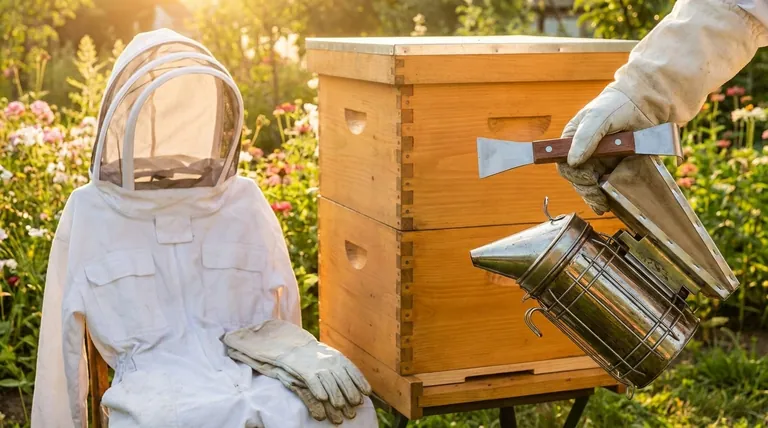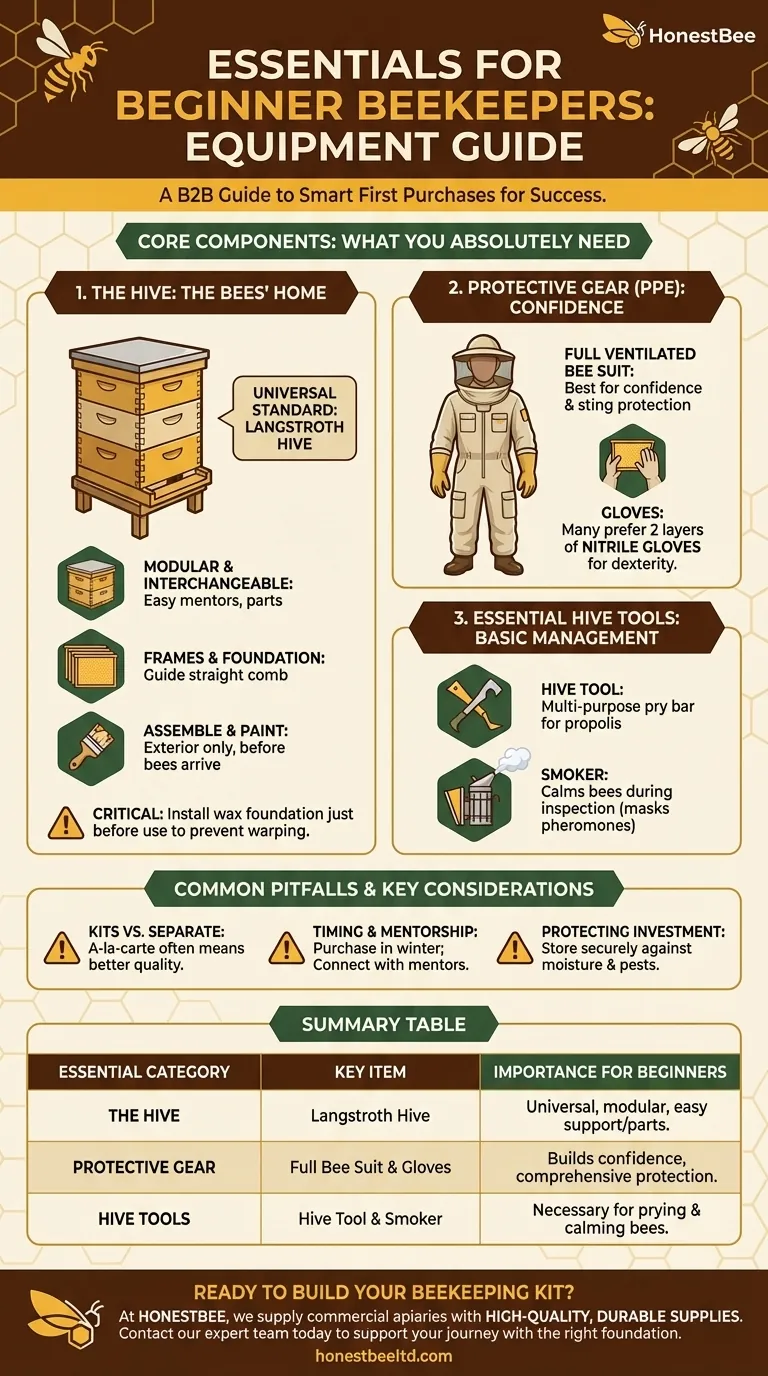Choosing your first beekeeping equipment requires focusing on three essential categories: the hive itself, your personal protective gear, and the basic tools for hive management. For beginners, the best approach is to start with standard, widely-used equipment that simplifies learning and allows for future expansion. This foundation ensures you are prepared, confident, and ready for your bees to arrive.
The goal is not to buy everything at once, but to acquire the correct foundational pieces. Prioritize a standard hive system, comprehensive protective gear, and the two most critical hand tools. This minimalist approach reduces initial cost and complexity, setting you up for a more successful first year.

The Core Components: What You Absolutely Need
Your initial purchase should be limited to the essentials. This prevents you from being overwhelmed with gear you don't yet need and allows you to invest in quality where it matters most.
Component 1: The Hive
The hive is the bees' home and your primary piece of equipment. While several styles exist, the Langstroth hive is the universal standard in North America and the best choice for a new beekeeper.
Its modular, interchangeable parts are widely available and understood by the beekeeping community, making it easy to find mentors and replacement components. A basic Langstroth setup includes a bottom board, one or two deep hive bodies, frames, foundation, an inner cover, and a telescoping outer cover.
When you purchase your hive, it will likely be an unassembled kit. You must allow adequate time for assembly and painting before your bees arrive. Only paint the exterior surfaces of the hive components, as the bees will manage the interior themselves.
Frames hold the honeycomb, and they are fitted with foundation—a sheet of wax or plastic that guides the bees in building straight comb. It is critical to avoid installing wax foundation into frames until just before you plan to use them. Improper storage, especially in warm temperatures, can cause the wax to stretch and warp.
Component 2: Personal Protective Equipment (PPE)
Confidence is key to calm hive inspections, and good PPE is what builds that confidence. Skimping on protective gear is a common mistake that can lead to a negative early experience.
For your first season, a full, ventilated bee suit is the best investment. While a simple jacket and veil combination is cheaper, a full suit provides complete protection that allows you to focus on the bees instead of worrying about stings.
You will also need gloves. Leather beekeeping gloves offer maximum protection but can be clumsy. Many beekeepers prefer using two layers of disposable nitrile gloves, which offer surprising sting resistance while preserving the dexterity needed to handle frames gently.
Component 3: Essential Hive Tools
You only need two tools to begin: a hive tool and a smoker.
The hive tool is your multi-purpose pry bar. Bees use a sticky substance called propolis to seal every crack in their hive, and the hive tool is essential for prying apart hive bodies and lifting out frames.
The smoker is used to calm the bees before and during an inspection. A few puffs of cool, white smoke mask the bees' alarm pheromones, making the colony less defensive. It does not harm them.
Common Pitfalls and Key Considerations
Avoiding a few common mistakes can save you significant time, money, and stress. The most critical factor is planning ahead.
All-in-One Kits vs. Buying Separately
Beginner kits that bundle everything together seem convenient, but they often include lower-quality items or tools you won't use.
Buying your hive, protective gear, and tools separately allows you to choose quality components where it matters most. This a-la-carte approach is often more cost-effective in the long run.
The Importance of Timing and Mentorship
Do not wait until spring to order your equipment. Purchase everything in the winter to give yourself several weeks for assembly, painting, and troubleshooting.
Assembling hive bodies can be confusing for a novice. This is the perfect opportunity to connect with an experienced beekeeper. Seeking help from a local beekeeping club or mentor is invaluable for getting started correctly.
Protecting Your Investment
Your equipment must be stored in a secure space that protects it from moisture, pests like mice and wax moths, and the elements.
A large closet, a dedicated section of a garage, or a small shed are all suitable options. Proper storage ensures your equipment remains in good condition for years to come.
Making the Right Choice for Your Goal
Your purchasing decisions should align directly with your primary objective as a new beekeeper.
- If your primary focus is simplicity and community support: Begin with a standard 10-frame Langstroth hive and invest in a full protective suit to build confidence.
- If your primary focus is managing a tight budget: Choose unassembled hive kits to save money, but be sure to factor in the time and effort required for proper assembly and painting.
- If your primary focus is long-term success: Connect with a local beekeeping association to find a mentor before you buy anything, and prioritize quality on your core equipment.
Making thoughtful initial choices in equipment is the first step toward a rewarding and successful beekeeping journey.
Summary Table:
| Essential Category | Key Item | Why It's Important for Beginners |
|---|---|---|
| The Hive | Langstroth Hive | Universal standard, modular design, easy to find support and parts. |
| Protective Gear | Full Bee Suit & Gloves | Builds confidence for calm inspections by providing comprehensive sting protection. |
| Hive Tools | Hive Tool & Smoker | Necessary for prying apart hive components and calming bees during inspections. |
Ready to build your beekeeping kit with confidence?
At HONESTBEE, we supply commercial apiaries and beekeeping equipment distributors with high-quality, durable supplies. Whether you're starting a new operation or scaling an existing one, our wholesale-focused operations ensure you get the reliable equipment you need for long-term success.
Contact our expert team today to discuss your specific needs and discover how we can support your beekeeping journey with the right foundation.
Visual Guide

Related Products
- Professional Dual-End Stainless Steel Hive Tool for Beekeeping
- HONESTBEE Advanced Ergonomic Stainless Steel Hive Tool for Beekeeping
- HONESTBEE Professional Multi-Functional Hive Tool with Ergonomic Wood Handle
- Wholesales Dadant Size Wooden Bee Hives for Beekeeping
- Professional 3-Bar Frame Grip with Integrated Hive Tool
People Also Ask
- What is a hive tool and what are its uses? Master Your Hive Inspections with the Essential Beekeeper's Tool
- What are the normal functions of a hive tool? The Essential Multi-Tool for Every Beekeeper
- What is the hive tool used for? The Essential Multi-Tool for Every Beekeeper
- What is a hive tool used for in beekeeping? Your Essential Guide to Hive Management
- How should beekeepers handle bees when using a hive tool? Master Calm, Deliberate Techniques



















